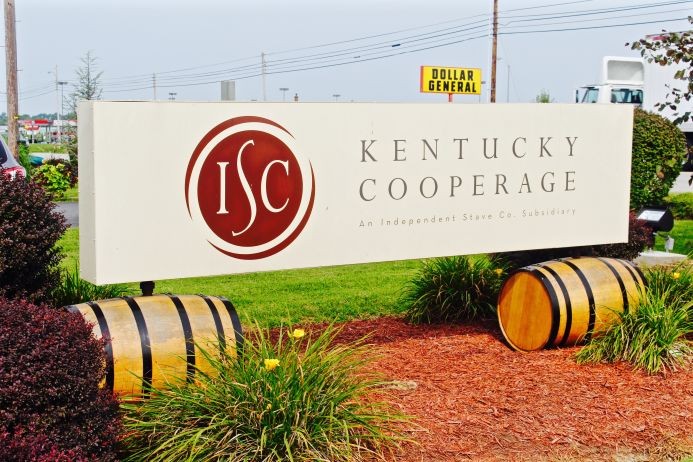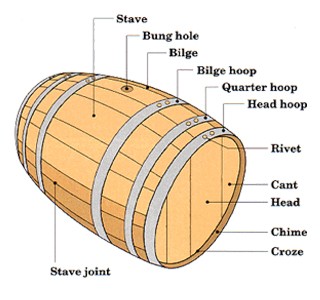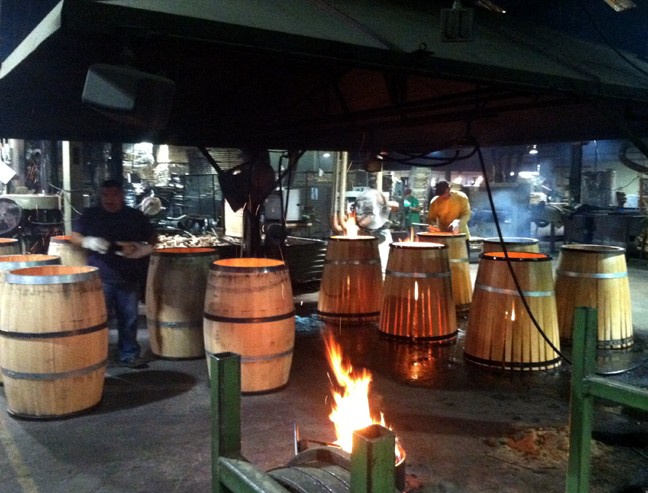Kentucky Cooperage- Independent Stave Company
Introduction
Text-to-speech Audio
Established in 1912 by T.W. Boswell to produce staves for barrel makers, Independent Stave Company expanded to include the production of white oak barrels for bourbon producers in 1951.The company later expanded to include cooperages that produce barrels for making wine and whiskey throughout the world. The company's Kentucky Cooperage offers public tours that last just under an hour and demonstrate the art of barrel making.
Images
Coopers build or maintains barrels while a "cooperage" is a facility for making barrels.

A diagram showing the parts of a barrel from Speyside Cooperage.

A view of the barrels before and after they are fired and charred.

Backstory and Context
Text-to-speech Audio
Barrel-making was one of the early and most essential skilled crafts, allowing for the storage and transportation of liquid. Staves are the oak planks that constitute the sides of a barrel. Each stave must be straight and free of knots, as well as properly fitted together to create a water-tight barrel. The staves are kept in place by metal hoops and liquid is added and removed through a hole in the side known as the bung.
The craft of making barrels has been kept alive largely owing to the producers of whiskey and wine. Charred white oak barrels are essential to aging bourbon, for it is during the multi-year process that the spirits interact with the wood in a way that gives bourbon its desired flavor. The process is similar for wine and other spirits, but the process of making bourbon requires a new barrel each time. The type of wood used in producing a barrel makes a tremendous difference in the taste of a bourbon. For example, American white oak can that has been properly charred can impart a spirit with sweet flavors such as vanilla, even though their is no actual vanilla used in the process of making bourbon.
Independent Stave Company operates cooperages in Lebanon, Missouri and Lebanon, Kentucky. Of these two locations, only the cooperage in Kentucky is open for tours. The company also operates subsidiaries that operate cooperages under the T. W. Boswell name in California, Chile, South Africa, Australia, and France. Many of the large bourbon producers, such as Jack Daniels, produce their own barrels.
The craft of making barrels has been kept alive largely owing to the producers of whiskey and wine. Charred white oak barrels are essential to aging bourbon, for it is during the multi-year process that the spirits interact with the wood in a way that gives bourbon its desired flavor. The process is similar for wine and other spirits, but the process of making bourbon requires a new barrel each time. The type of wood used in producing a barrel makes a tremendous difference in the taste of a bourbon. For example, American white oak can that has been properly charred can impart a spirit with sweet flavors such as vanilla, even though their is no actual vanilla used in the process of making bourbon.
Independent Stave Company operates cooperages in Lebanon, Missouri and Lebanon, Kentucky. Of these two locations, only the cooperage in Kentucky is open for tours. The company also operates subsidiaries that operate cooperages under the T. W. Boswell name in California, Chile, South Africa, Australia, and France. Many of the large bourbon producers, such as Jack Daniels, produce their own barrels.
Sources
Michael Veach, "What Happens To Whiskey In The Barrel?" Bourbonveach.com February 1, 2016 (accessed 11/15/2016) https://bourbonveach.com/2016/02/01/what-happens-to-whiskey-in-the-barrel/
"About Us," Independent Stave Company. Accessed November 15, 2016. http://www.independentstavecompany.com/about_us.
"About Us," Independent Stave Company. Accessed November 15, 2016. http://www.independentstavecompany.com/about_us.
